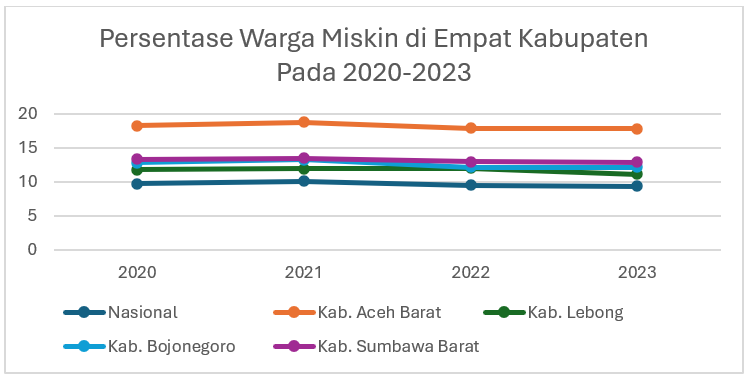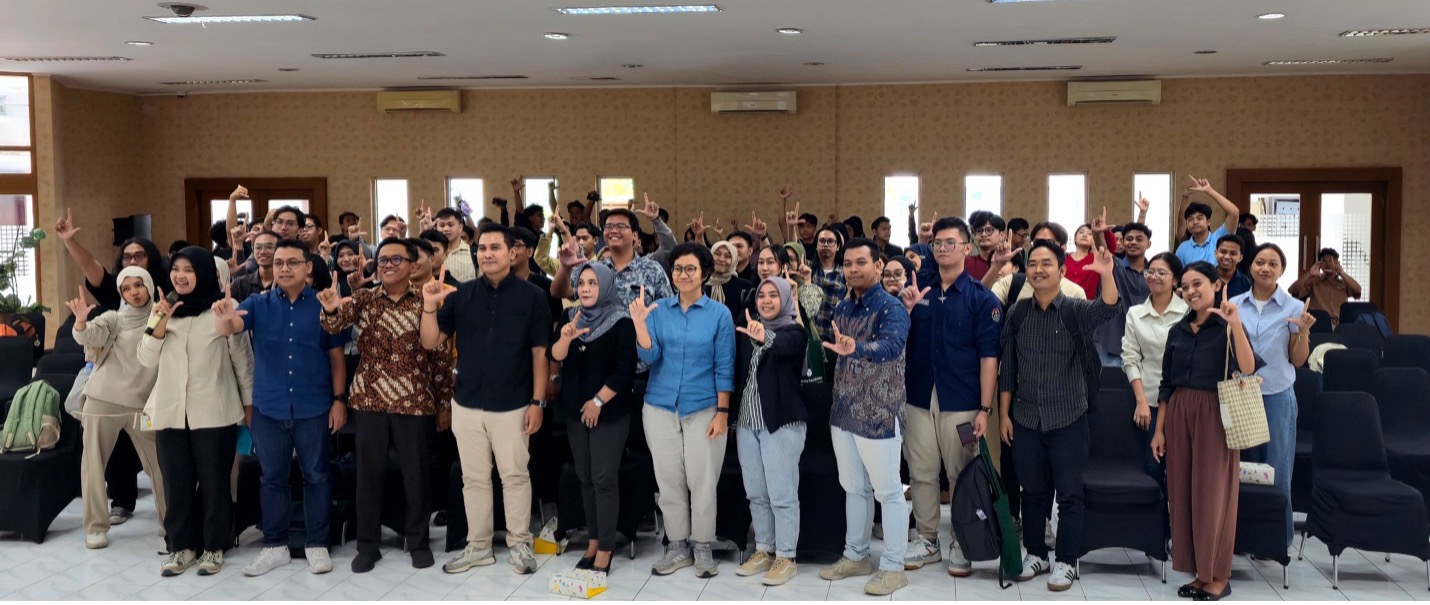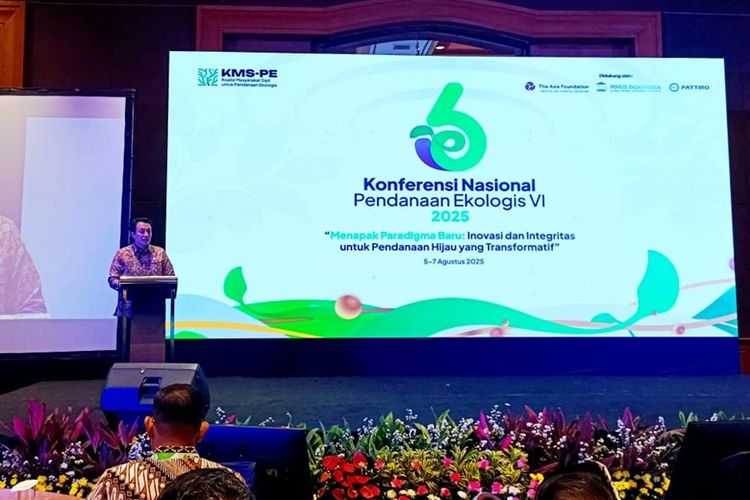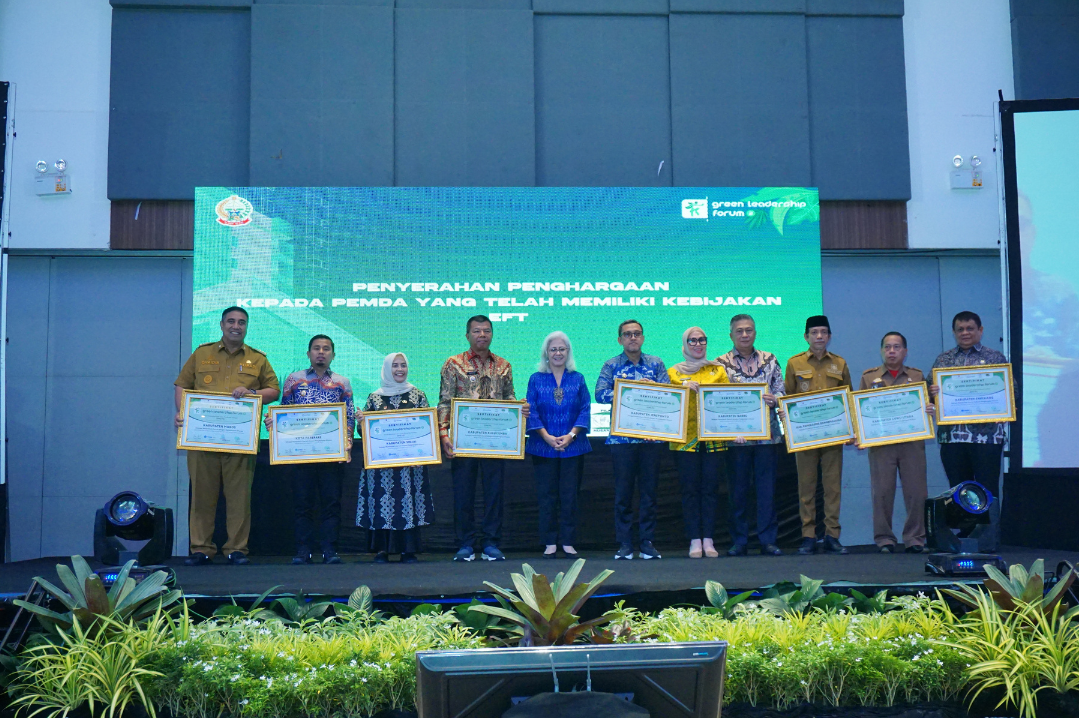Mining-rich areas such as West Aceh, Lebong, Bojonegoro and West Sumbawa regencies have high natural resource (SDA) potential because they are areas that have extractive industries. However, unfortunately, these four regions still face challenges in the form of high levels of poverty.
Based on a study by PATTIRO in collaboration with the Bojonegoro Institute, Akar Global Initiative, SOMASI NTB, and MaTa Aceh, in 2020-2023 the percentage of poor people in West Aceh, Lebong, Bojonegoro, and West Sumbawa Regencies is still above the national poverty rate percentage, but tends to show decreasing trend every year, especially in 2023.
Sumber: Hasil Olahan Tim Peneliti (2024)
These four districts already have regulations regarding the formation of the Regional Poverty Reduction Coordination Team (TKPKD). However, the existing TKPKD does not involve wider stakeholders. This broader stakeholder involvement can capture more diverse aspirations regarding regional poverty alleviation programs.
Poverty alleviation programs have also been included in regional planning documents, such as the Regional Poverty Alleviation Plan (RPKD) and the Annual Action Plan (RAT). However, many poverty reduction programs in districts do not yet synergize with existing programs in villages. Apart from that, there is no clear mandate for budget allocation for poverty reduction programs. Village Fund Allocations (ADD) have not been used optimally for poverty alleviation programs because most of them have been allocated for the fixed income of village heads and village officials.
There needs to be policy strengthening to optimize poverty reduction efforts in mining-rich areas so that people in these areas are not like chickens that die in rice barns, who have great regional potential but cannot manage that potential well.
PATTIRO Executive Director, Bejo Untung in his presentation at the Focus Group Discussion Encouraging Optimization of Poverty Alleviation in Mine-Rich Areas on Tuesday (2/7) revealed that PATTIRO recommends that the district government optimize the management of regional income originating from mining revenues to encourage poverty alleviation programs in mining-rich villages. . “This can be done by optimizing the CSR management of mining businesses and DBH natural resources transferred through ADD for the allocation of poverty reduction programs,” said Bejo.
This statement was confirmed by the Director of Regional Budget Planning, Directorate General of Regional Financial Development, Ministry of Home Affairs (Kemendagri), Bahri, who explained that the priority for using revenue originating from mining businesses was to implement poverty reduction programs. This is part of the implementation of sustainable development goals whose policies and programs should be included in regional development planning documents.
“The Ministry of Home Affairs, through regional heads, ensures the accuracy of targeting and integration of programs between levels as well as broad community involvement through accelerated poverty reduction strategies which include reducing the burden of community expenditure, increasing community income and reducing the number of pockets of poverty,” explained Bahri.
CSR Management of Mining Businesses
Law Number 40 of 2007 concerning Limited Liability Companies states that companies that carry out business activities in the field and/or related to natural resources are obliged to carry out social and environmental responsibilities. This social and environmental responsibility is realized through budgeting CSR funds for social programs and activities in the area around the business.
Analysis and Data Tool Development Specialist, National Team for the Acceleration of Poverty Reduction, Alie Sadikin, said that regional governments and the non-government sector can collaborate in poverty reduction programs by ensuring that the locus of CSR programs is in priority areas for reducing extreme poverty in mining-rich areas. CSR programs for poverty alleviation can be carried out in two categories, namely burden reduction and community empowerment. “This program can utilize ranked P3KE data to determine target recipients,” explained Alie.
In this case, West Aceh Regency has regulations regarding the use of CSR funds from mining companies to overcome extreme poverty, namely the Decree of the Regent of West Aceh Number 605 of 2021 concerning Amendments to the Decree of the Regent of West Aceh Number 799 of 2019 concerning the Establishment of a Social and Environmental Responsibility Forum West Aceh Regency Company in 2021.
SDA DBH Management Through ADD Transfer
Policy Analysis by the Associate Expert for Village and Rural Socio-Cultural and Environmental Development at the Ministry of Villages, Anastutik Wiryaningsih, confirmed that alleviating poverty and extreme poverty is indeed one of the priorities for using Village Funds. Apart from that, village funds can also be used for capital assistance for BUM Desa/BUM Desa Bersama. It is hoped that businesses that are provided with capital assistance through the Village Fund can utilize the potential of existing mining or ex-mining areas for other sectors. “The former mining area has the potential to be used for fishing, tourism or for food security,” added Anastutik.
Bojonegoro Regency has regulations that regulate the allocation of village funds to regulate the proportion of Village Fund transfers originating from the Oil and Gas DBH, namely Regent Regulation Number 31 of 2009 concerning Guidelines for Determining Proportional Village Fund Allocations Based on Regional Variable Coefficients. In 2023, there will be two villages that will be beneficiaries of this ADD, namely Mojodelik Village—receiving ADD of 2.92 billion rupiah—and Gayam Village—receiving ADD of 2.85 billion rupiah.
The initiatives that have been carried out by West Aceh Regency and Bojonegoro Regency are bearing good fruit. In 2023, West Aceh Regency and Bojonegoro Regency succeeded in receiving fiscal incentives from the central government for the category of eliminating extreme poverty amounting to 5.5 billion rupiah and 5.6 billion rupiah respectively.
The provision of fiscal incentives from the central government needs to continue to be encouraged to provide leverage for poverty reduction programs in local governments. Head of the Social and Cultural Sub-Directorate of the SUPD III Directorate General of Regional Development, Ministry of Home Affairs, Wahyu Suharto, said that the provision of fiscal incentives for the category of eradicating extreme poverty has been carried out since 2023. For 2024, the indicators set for this category of fiscal incentives are the determination of the TKPK Decree, the determination 2021 RAT, Decree on Determining Regional P3KE Data, attachment to the Decree on Determining Regional PPKE Targeting Data or Verval P3KE Data, PPKE reporting for TW I and TW II 2024, realization of expenditure tagging extreme poverty.






